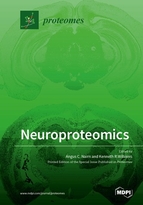Neuroproteomics
A special issue of Proteomes (ISSN 2227-7382).
Deadline for manuscript submissions: closed (15 March 2019) | Viewed by 107240
Special Issue Editors
Interests: dopamine; Alzheimer disease; Parkinson disease; protein phosphorylation; signal transduction
Special Issues, Collections and Topics in MDPI journals
Interests: mass spectrometry; quantitative proteomics; neuroproteomics; disease biomarkers
Special Issues, Collections and Topics in MDPI journals
Special Issue Information
Dear Colleagues,
Recent advances in mass spectrometry (MS) instrumentation that enable the level of quantitation of expression of ~8000 proteins to be interrogated by LC/MS/MS analysis have opened the door to the proteome and already are having an impact that extends from biology to clinical proteomics. With no theoretical limits in sight with regard to further improvements in MS instrumentation and when coupled with new chemical labelling technologies that incorporate multiple isobaric tags that enable the concurrent analyses of up to 11 different samples using commercially available reagents, and improved peptide identification algorithms and bioinformatics; the future of MS-based, quantitative proteomics is incredibly promising and exciting for mass spectrometrists and for the much larger numbers of investigators whose research now depends upon MS/proteomics analyses. While these methods are beginning to be applied to neuroproteomics, the central nervous system (CNS) poses many challenges to quantitative proteomics that begin with the immense level of cellular and sub-cellular heterogeneity. The CNS has ~100 billion neurons, each with 10,000 to 100,000 synaptic connections; and even larger numbers of glial cells. Moreover, there is a large variety in cell morphology with individual neurons typically being intermingled in close contact with several different types of neurons and with axonal projections from an individual neuron often projecting over relatively long distances. Given that it is now clear that each of the ~1000 individual types of nerve cells exhibit distinct patterns of gene expression, it is critically important to develop and publish the technologies and methodologies needed to enable quantitative MS/proteomic analyses of specific neuronal cell types and their organelles.
While the whole brain or large regions of brain tissue can be used for proteomic analysis, the useful information that can be gathered is limited because of cellular and sub-cellular heterogeneity. Analysis of mixed populations of distinct cell types not only limits our understanding of where a particular protein expression change might have occurred, it also minimizes our ability to detect significant changes in protein expression and/or modification levels due to issues related to low signal to high noise.
This Special Issue will contain research and review articles that cover whole proteome analysis, comparative proteomics, protein structure/function, protein post-translational modifications, protein:ligand and protein:protein interactions within normal and diseased neurological tissues. Since the huge level of cellular and sub-cellular heterogeneity in the CNS is the greatest obstacle impeding progress towards understanding the adaptive molecular changes that underlie drug addiction and that occur in other neurological diseases, we are especially interested in manuscripts that describe the use of laser capture microscopy, fluorescence cytometry-related, and immuno-affinity technologies in conjunction with transgenic and viral methods to isolate and study neural cell type- and organelle-specific proteomes. Manuscripts are also especially sought that describe the development and use of technologies such as “Top-Down” to identify combinatorial epigenetic changes in histone modification and targeted MS to obviate the stochastic nature of discovery MS/proteomics that are applicable to neurological analyses. Another area of special interest is the use of bioinformatics approaches to integrate RNA and protein level analyses so peptide identification rates can be improved by carrying out MS/MS database searches on brain region- and cell type-specific proteomes that have been predicted based on RNA-sequencing.
We very much look forward to receiving your manuscripts and compiling an outstanding collection of review and original research articles that will advance the field of neuroproteomics.
Sincerely,
Prof. Dr. Angus C. Nairn
Dr. Kenneth R. Williams
Guest Editors
Manuscript Submission Information
Manuscripts should be submitted online at www.mdpi.com by registering and logging in to this website. Once you are registered, click here to go to the submission form. Manuscripts can be submitted until the deadline. All submissions that pass pre-check are peer-reviewed. Accepted papers will be published continuously in the journal (as soon as accepted) and will be listed together on the special issue website. Research articles, review articles as well as short communications are invited. For planned papers, a title and short abstract (about 100 words) can be sent to the Editorial Office for announcement on this website.
Submitted manuscripts should not have been published previously, nor be under consideration for publication elsewhere (except conference proceedings papers). All manuscripts are thoroughly refereed through a single-blind peer-review process. A guide for authors and other relevant information for submission of manuscripts is available on the Instructions for Authors page. Proteomes is an international peer-reviewed open access quarterly journal published by MDPI.
Please visit the Instructions for Authors page before submitting a manuscript. The Article Processing Charge (APC) for publication in this open access journal is 1800 CHF (Swiss Francs). Submitted papers should be well formatted and use good English. Authors may use MDPI's English editing service prior to publication or during author revisions.
Keywords
- neuroproteomics
- quantitative proteomics
- isobaric chemical labeling
- label-free quantitation
- parallel reaction monitoring
- multiple reaction monitoring
- mass spectrometry
- discovery mass spectrometry
- targeted mass spectrometry
- data-dependent acquisition
- data-independent acquisition








